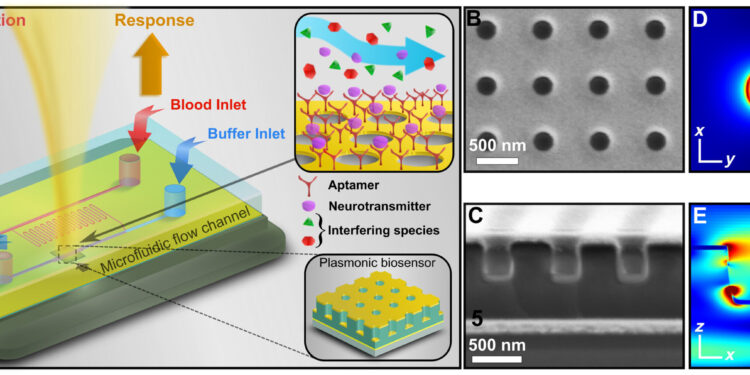Description of the plasmonic biosensor platform. (A) Schematic of the integrated plasmonic biosensor platform. The upper inset shows the specificity of the surface-functionalized DNA aptamer in the presence of other interfering species, where the aptamer selectively binds to dopamine. The lower inset shows a cartoon representation of the plasmonic biosensor. (B and C) Scanning electron microscopy (SEM) image of the biosensor showing a surface view (B) and a cross-sectional view (C). (D and E) Local electric near-field enhancement predicted by finite-difference time-domain (FDTD) at λ = 842 nm, 2 nm above the surface (D) and the cross-section (bottom). Credit: Scientific progress (2024). DOI: 10.1126/sciadv.adp7460
Dopamine, a neurotransmitter found in our brain, not only regulates our emotions, but also serves as a biomarker for screening for certain cancers and other neurological conditions.
Researchers at the University of Central Florida, led by Professor Debashis Chanda of the UCF Center for Nanoscience Technology, have developed an integrated optical sensor that can detect dopamine directly from an unprocessed blood sample. This sensor could serve as an inexpensive and effective screening tool for a variety of neurological diseases and cancers, leading to better patient outcomes.
The study is published in the journal Scientific progress.
“This plasmonic biosensor is extremely sensitive to low concentrations of biomolecules, making it a promising platform for specialized testing and point-of-care applications in remote locations,” said Chanda, the study’s principal investigator, who also holds appointments in the UCF Department of Physics and CREOL, the College of Optics and Photonics.
“In this work, we demonstrated a fully optical, surface-functionalized plasmonic biosensing platform for the detection of low concentrations of the neurotransmitter dopamine directly from various biological samples, which include protein solutions, artificial cerebrospinal fluid, and unprocessed whole blood.”
Neurotransmitters play a vital role in regulating neuronal functions and overall well-being in humans and animals. A harmonious balance of neurological hormones is therefore necessary for the body to function optimally, Chanda explains. Dopamine is a vital transmitter because it has a significant influence on cognitive processes such as motor functions or emotions such as happiness or pleasure.
Disruptions in dopamine levels are closely linked to various neurodegenerative disorders such as Parkinson’s disease and Alzheimer’s disease, neurodevelopmental disorders such as attention deficit hyperactivity disorder and Tourette syndrome, and psychological disorders such as bipolar disorder and schizophrenia, Chanda says.
Deviations from normal dopamine levels can also serve as an important diagnostic marker for certain types of cancer. Accurate and reliable measurement of dopamine concentrations is of utmost importance for advancing pharmaceutical research and medical therapies, Chanda says.
How it works
The plasmonic sensor consists of a tiny gold pattern that causes electrons to move in waves. These waves, called plasmons, become stronger thanks to a special optical configuration. When a new molecule enters the sensor’s environment, it changes the way the electrons move, which affects how light is reflected by the sensor. This change in reflection makes it possible to detect the presence of the molecule.
Unlike traditional biosensors that rely on biological elements like antibodies or enzymes, the UCF-developed device uses a specially designed aptamer—a synthetic strand of DNA—to precisely detect dopamine. This approach not only makes the sensor more cost-effective and easier to store, but also allows the device to detect dopamine directly from raw blood, without any preparation. This advancement could be particularly valuable in areas with limited medical resources, as it simplifies the detection process and opens the door to diagnosing other conditions using the same technology.
The researchers were able to target specific molecules by coating the active area of the sensor with an aptamer specifically created to bind to a particular biomarker with great precision.
The study results highlight the potential of plasmonic “aptasensors” using aptamers to detect the development of rapid and accurate diagnostic tools for disease monitoring, medical diagnostics and targeted therapies, the researchers say.
“There have been many demonstrations of plasmonic biosensors, but none of them are able to detect the relevant biomarker directly from untreated biological fluids, such as blood,” says Aritra Biswas, Ph.D., lead author of the paper.
The new research builds on the team’s previous work to develop a dopamine sensor by replacing cerium oxide nanoparticles with DNA-based aptamers, thereby improving the sensor’s selectivity and expanding its applicability to detect dopamine directly in various biological samples without requiring prior sample preparation.
“This concept can be explored further in the detection of different biomolecules directly from untreated blood, such as proteins, viruses or DNA,” says Chanda. “It could be of great interest in developing countries where access to analytical laboratories is limited.”
More information:
Aritra Biswas et al, Nanoplasmonic Aptasensor for Sensitive, Selective and Real-Time Detection of Dopamine from Unprocessed Whole Blood, Scientific progress (2024). DOI: 10.1126/sciadv.adp7460
Provided by the University of Central Florida
Quote: Researchers develop rapid test to detect dopamine (2024, September 5) retrieved September 5, 2024 from
This document is subject to copyright. Apart from any fair dealing for the purpose of private study or research, no part may be reproduced without written permission. The content is provided for informational purposes only.



